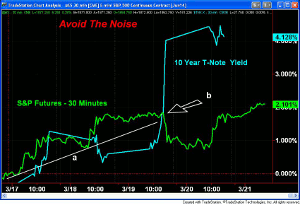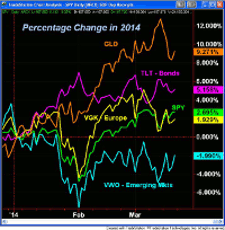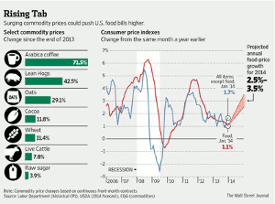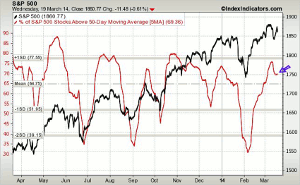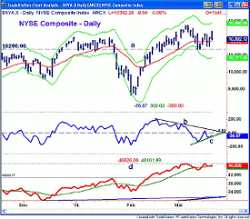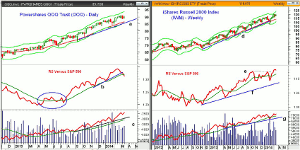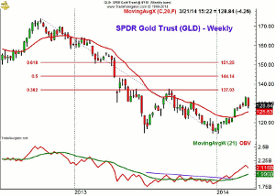The end of another choppy trading week served as a reminder that the stock market can go down as well as up, and MoneyShow’s Tom Aspray counsels market participants to have an action plan ready and stick to it, so they don’t succumb to panic selling when volatility hits.
It was another rollercoaster week in the global equity markets but that has really been the trend so far in 2014, even though many of the US averages have made new all-time highs. The volatility is thought to be a friend of the trader, but I heard one commentator on national TV say that “he had been wrong for the last 60 points in the S&P.”
Of course, no active trader would ever risk that large an amount on their view of the market’s direction. It does illustrate that it hasn’t been an easy year for many traders as those who have been shorting the market since early in the year had to be very nimble in order to profit. But what is the investor to do?
This 30-minute percentage change chart tracks the S&P 500 futures and the 10-year T-note from Monday through Friday morning. The two-day uptrend in the S&P futures, line a, was broken on Wednesday at 2:00 pm Eastern time (see arrow). The futures were up around 1.8% and then quickly dropped to up just 0.75% early Thursday.
At the same time, yields were just as wild as they started to rise before the S&P futures broke support. The 10-year yield went from up 0.75% for the week to up over 4% in less than 24 hours. The actual yield jumped from 2.67% to 2.78%.
As I mentioned in Thursday’s column, I thought that the decline, Wednesday, was a mis-interpretation of Yellen’s comments and nothing had really changed for the stock market. Hopefully, investors ignored the market’s reaction but it’s events like this, as well as the sharp selloff in early February, that makes it imperative for investors to have a plan.
Depending on your age and your financial status, I think everyone should have a commitment to the stock market as long as the NYSE Advance/Decline stays positive and economic indicators like the LEI show no signs of a recession. For those who do not want to study the market, a passive approach that invests in low-cost index-tracking ETFs that follow US, as well as overseas stocks, would be the best bet. But what should the more active investor do?
The % change in the various asset classes show quite a few wide swings already this year. Gold as represented by the SPDR Gold Trust (GLD) has been the clear winner, up about 9.3%, but down from the mid-March high of 12.7%. Bonds are next as the iShares 20+ Year Treasury Bond ETF (TLT) is up just over 5%.
As of early Friday, the Spyder Trust (SPY) is up 2.6% while the Vanguard European Stock Index (VGK) is trailing a bit, up 1.9%. The emerging markets, as represented by the Vanguard Emerging Markets Index (VWO) were unchanged for the year in late January, but by early February, were down 7.6% for the year. VWO has improved from its worst levels as it is currently down just 2% for 2014.
I still think the emerging markets may be the surprise in 2014 as the technical outlook has improved but a bottom has not yet been confirmed. The more active investor should consider investing in several index-tracking ETFs, but in volatile areas, like the emerging markets, the percentage commitment should be kept low. One should consider not only the large-cap S&P 500 but also the small-cap sectors like iShares S&P 600 Small-Cap (IJR), which I recommended last Wednesday.
If you are willing to spend the time and do the work, I think you can become your own investment analyst. These more active investors should consider a core position in an S&P-500-tracking ETF and then allocate to other industry-specific ETFs. So far in 2014, the Select Sector SPDR Utilities (XLU) is up 8.8% for the year. Not too far behind is the Select Sector SPDR Health Care (XLV), which is up 7.8%.
With the recent decline in many of the high-flying biotechnology stocks, the PowerShares QQQ Trust (QQQ) is up 3.8%. Those who have been in either the Select Sector SPDR Energy (XLE) or the SPDR Dow Industrials (DIA) are pretty much flat for the year. This illustrates the importance of sector selection, and I have found relative performance to be the best tool. Using this approach to diversify your 401k in different sectors has shown to work quite well. (Learn to Drive Your Own 401k).
NEXT PAGE: What to Watch
|pagebreak|For those investors who want to spend at least a few hours each weekend working on their portfolios, a combination of market-tracking ETFs and individual stocks should give one the best upside potential. The correlation between stocks and the overall market has declined significantly from the same time last year and this is a plus for stock pickers.
In this week’s trading lesson, 6 Picks in Seasonally Strong Sectors, I focused on six picks and the recommendations for many were tweeted out before the stock market’s opening on March 19. Those who want to follow these recommendations, as well as those in the Charts in Play column, should also follow my Twitter feed.
Whatever type of investor you are, be sure to develop a plan and stick to it. Then, when the market is going through one of its volatile phases, you won’t sell out in a panic. I do not use stops on core mutual fund or long-term ETF positions that are established by dollar cost averaging, but I rely on the intermediate-term signals from the NYSE Advance/Decline.
For the more active approaches, it is critical that you focus on the risk of any new positions as it is those 15% or more losers that can really kill a portfolio’s performance. Be sure your stops are placed with regards to the entry, and therefore the risk, because if the risk is too high, you should find another stock or ETF to buy.
Beating the yield on the 10-year T-note will be important as living costs continue to rise. The current drought conditions in the West and the possible return of El Niño are likely to increase food costs even more. As the table indicates, the cost of Arabica coffee is already up over 71%, so far in 2013, with lean hogs up 42.5%. This is especially discouraging for those with families as their food costs are already high. The Wall Street Journal is projecting a 2.5-3.5% rise in food prices in 2014, so a 2.75% yield in T-notes won’t keep pace with rising food costs.
Last week’s economic data overall was good as Industrial Production and the Philadelphia Fed Survey were much better than expected. The Leading Economic Indicators also rose 0.5% this month and the strong uptrend in last week’s chart clearly points to a steadily improving economy.
The data on housing was mixed but it will be the next several months that are the key. The Housing Market Index and Existing Home Sales data were weaker than expected while the Housing Starts met expectations.
On Monday, we will get the flash PMI Manufacturing Index, followed on Tuesday by the S&P Case-Shiller Housing Price Index, New Home Sales, and Consumer Confidence. The latest data on Durable Goods comes out on Wednesday followed by the final 4th quarter GDP reading on Thursday. Also on Thursday we get the jobless claims and the Pending Home Sales Index.
The final reading on Consumer Sentiment from the University of Michigan is out on Friday as is the Personal Income and Outlays report.
What to Watch
The stock market won out last week though it was not an easy ride. The bond market was also quite volatile but last week’s argument for stocks over bonds has not changed. The action early in the week may tell us whether the S&P 500 is going to challenge the 1900 level or if it is going to meander in its trading range of 1820-1884.
The further new highs in the A/D line continues to favor an eventual move to the upside. There were signs from the retail sector last week that the consumer discretionary may be ready to come back strong.
It along with the financials and healthcare sectors are in a strong seasonal period. Several stocks and an ETF from these sectors were the focus of this week’s 6 Picks in Seasonally Strong Sectors. The action of the regional banks has been quite impressive as a few have broken out to the upside.
As I have been saying for several weeks, the relatively high bullish sentiment and moderately overbought status of the market does not warrant a complacent approach. Therefore, I updated the stops in the Charts in Play portfolio last week and took some more profits.
According to AAII, the individual investors are a bit less bullish now at 36.78%, down from 41.34%, as Yellen’s comments must have gotten their attention. Only 26.15% are bearish, which is still too low as it was 36.41% on February 6.
NEXT PAGE: Stocks
|pagebreak|The five-day MA of the percentage of S&P 500 stocks above their 50-day MAs has fallen to 69.6% from the 76% area and the MA is trying to turn up again.
The daily chart of the NYSE Composite shows that the 10,266 level, line a, was tested last week and it has held so far. The monthly pivot support is at 10,209 with the quarterly pivot at 10,082. Based on current data, the quarterly pivot will be at 10,232 in April.
The daily starc- band is at 10,177 with further support in the 9900 to 10,000 area. Initial resistance stands now in the 10,400-500, and a close above this level, will confirm the resumption of the uptrend.
The McClellan oscillator popped up to +57 last Tuesday before dropping down to -63 on Thursday. It is trying to turn up and shows a short-term uptrend, line c. A strong move above the prior high and the downtrend, line b, will confirm higher prices.
The daily NYSE Advance/Decline made a convincing new high on Tuesday though it is not as clear from this chart. Those of you who follow the A/D line on stockcharts.com will be convinced. The A/D line is holding above its WMA.
S&P 500
The daily chart of the Spyder Trust (SPY) shows Friday’s spike to a new high at $189.02 as it held above its 20-day EMA at $186.20 on a closing basis all week. It ended lower for the day but still higher for the week. The daily starc- band is now at $182.72 with monthly pivot at $182.38, line a.
The resistance stands in the $189-$190 area and a close above $190 will signal a move to the weekly starc+ band now at $193.41.
The daily OBV is still lagging the price action as it has formed lower highs. The OBV is slightly below its WMA with next good support at line c. The weekly OBV (not shown) is still holding well above its WMA and did confirm the recent highs.
The daily S&P 500 A/D line bounced from its WMA last week and now has first strong support at the March 13th lows, with then further support at line d.
Dow Industrials
The SPDR Dow Industrials (DIA) surged in early trading Friday to a high of $164.20 but was not able to hold its gains in late trading. The quadruple witching action likely did not help. A strong close above the resistance at $164.77 would be quite positive and likely mean a rally to new highs.
There is important support now in the $160.52 area with the daily starc- band at $159.17.
The on-balance volume (OBV) still shows lower highs, line g, which is not a positive sign as it is still below its WMA. In contrast, the weekly OBV (not shown) has just moved back above its WMA.
The daily Dow Industrials A/D line did bounce off good support two weeks ago and is just holding above its WMA.
Nasdaq-100
The PowerShares QQQ Trust (QQQ) closed the week higher but well below its best levels. Last week, a low close doji sell signal was triggered and the QQQ needs to move above $91.36 to reverse this signal.
There is next support at $88.45 and the monthly pivot. The 20-week EMA is at $86.17 and the trend line support is at $85.50. This also coincides with the weekly starc- band.
The weekly relative performance will close the week below its WMA as it had broken its daily support several weeks ago when the uptrend, line b, was broken. At this point, one can’t tell whether this is a real change in leadership or just a pause like we saw in the IWM earlier in the year.
The weekly OBV continues to look very strong and it is close to its all-time highs as it rose last week. It is well above the support at line c and its rising WMA. The daily AOT moved firmly into the sell mode on March 6 and has not moved back into the buy mode.
The Nasdaq 100 A/D line did make not make a new high last week and has dropped below its WMA. There is first resistance now at $90.65-$91.
Russell 2000
The iShares Russell 2000 Index (IWM) has moved sideways for the past three week after testing its weekly starc+ band, but is still the best major sector ETF. This band is now at $123.67, which corresponds nicely with the projected monthly pivot resistance at $123.40.
There is minor support now at $117.50-$118 and then in the $115.60-$116.30 area. The strongly rising 20-week EMA is at $113.36.
The weekly relative performance has now moved to new highs as it overcame resistance at line e, signaling that it is still a market leader. There is key support at the early February lows.
The weekly OBV still looks strong as it is above its flat WMA. It made a new high just a few weeks ago. The daily OBV is ready to close below its WMA so the multiple time frame OBV analysis is still mixed.
The Russell 2000 A/D line has held above good support and its flat WMA.
NEXT PAGE: Sector Focus, Commodities, and Tom's Outlook
|pagebreak|Sector Focus
The iShares Dow Jones Transportation (IYT) was higher for the week but looks ready to form a doji, which is a sign of indecision. The daily chart shows what appears to be a continuation pattern, which would be completed by a close above $136.20. This would give upside target in the $139-$140 area with the weekly starc+ band at $140.70.
There is minor support now at $133 with the likely quarterly pivot next month at $132.60. The rising 20-day EMA is now just below $130.
The weekly relative performance (not shown) IS still above their WMA and the OBV turned up this week. In contrast, the daily technical studies are below their WMAs.
The SPDR Dow Industrials (DIA) is still down for the year while the iShares Russell 2000 Index (IWM) is up over 2.5% for the year. The PowerShares QQQ Trust (QQQ) is up just 1.25 while the Spyder Trust (SPY) is only up 0.8%.
Before the close, it seems like five of the 16 ETFs I follow for the year are still in negative territory. The Select SPDR Consumer Discretionary (XLY) and the Select SPDR Energy (XLE) are both down around 1.5% for the year but some of the apparel stocks helped the XLY last week.
The Select SPDR Materials (XLB) are still holding well in positive territory but traded in a narrow range last week. It needs to move above the $48 level to signal a new rally phase.
The Select SPDR Financials (XLF) had a good week as it is now up 2.6% for the year as the regional banks are looking quite strong and are some of my favorites.
The Select SPDR Industrials (XLI) are down just a bit for the year, but as I noted earlier, the Transports are higher.
Crude Oil
Crude oil firmed up late in the day Friday and closed the week a bit higher over geopolitical concerns. The first support in the $96-$97 area, basis the June contract, seems to be holding. The weekly OBV is still clearly positive as it is above its rising WMA.
Precious Metals
Both the SPDR Gold Trust (GLD) and the Market Vectors Gold Miners (GDX) were under pressure last week though GLD did close well above its lows. On the weekly chart, the setback seems quite mild but the miners have been hit harder.
The weekly OBV has turned lower but is still well above its rising WMA. The daily OBV is below its WMA but is now trying to turn up.
The Week Ahead
The action last week was positive overall even though stocks gave up their early gains on Friday. Option and futures expiration, as well as rebalancing by several large companies, did not help. A pricing concern also dragged the biotech stocks and the Nasdaq lower. The Nasdaq Biotech Index was down over 4%.
Last week, I was looking for a rally into the middle of the week and that rally was stronger than expected as the NYSE Advance/Decline made new highs. Wednesday’s selloff was not as bad as it could have been as it did not smack down the rally. Thursday’s early selling was also well absorbed, and I think this is more important than Friday’s weak close.
That does not mean that the market will accelerate to the upside as it can be range bound while some stocks, like the regional banks, continue to act better than the overall market. I will also be watching the retail stocks as they could provide new leadership if the consumer comes back and shops.
Be sure to keep watching any stocks in your portfolio and note how they are doing when compared to the S&P 500. Adjust your stops if you see a stock that is starting to lag, and if you are getting nervous about your position in the stock market, take some profits as you can always get back in.
There is no change for those who are following the dollar cost averaging in an S&P 500-tracking ETF or mutual fund that I recommended in the January 24 column, A Path to Investing Success in 2014.
Those who are not invested at all should consider starting a dollar cost averaging plan if the S&P 500 drops to 1795 or lower. Make your investment then and then four more equal purchases every two weeks.
I will be on vacation next week and the next Week Ahead column will be released on April 4.
Don't forget to read Tom's latest Trading Lesson, 6 Seasonally Strong Sectors.

